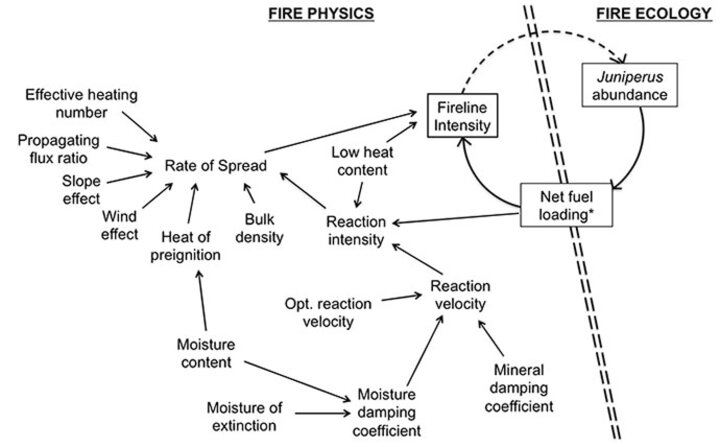Human behavior has rapidly shifted from fire-promoting to aggressively attempting to minimize its magnitude and variability. Today, nearly every region in the world enforces policies and laws that dictate when humans can ignite fires for the purposes of conserving fire-dependent ecosystem services. This globally-observed shift in human behavior is an example of unprecedented global environmental change that we hypothesize is a leading reason for the loss of grasslands, savannas, and other fire dependent ecosystems. Our research team is developing models and conducting experimental manipulations to evaluate how variability in fire regimes have changed as a result of contemporary social-ecological constraints and how these feedbacks influence alternative state dynamics. To better understand the underlying mechanisms of these relationships, we have linked knowledge from applied fire physics to fire ecology and are expanding on the model, through additional simulations and field experimentation, to include human decision-making and greater ecological complexity.
One area of research we continue to develop is the role of extreme fire in ecological assembly and its potential application in ecosystem management. Extreme fire is a technical term that has been used commonly in the U.S. wildland fire community since the 1950s. Extreme- implies a level of fire behavior characteristics that ordinarily precludes methods of direct control action (NWCG 2012) and has been used to describe atypical behavior in high intensity fires that lead to blow-ups, fire storms, fire whirls and other forms of erratic fire behavior. More recently, a review of the knowledge of extreme fire behavior by Werth et al. (2011) defined extreme fire as "fire spread other than steady surface spread, especially when it involves rapid increases." Their review highlights the lack of knowledge on the ecological effects of extreme fire behavior, which is a central focus of our research team.

Extreme prescribed fire in NW Oklahoma. Photo taken by Dirac Twidwell.

Twidwell, D., W.E. Rogers, S.D. Fuhlendorf, C.L. Wonkka, D.M. Engle, J.R. Weir, U.P. Kreuter, C.A. Taylor, Jr. 2013. The rising Great Plains fire campaign: citizens- response to woody plant encroachment. Frontiers in Ecology and the Environment 11: e64-e71.
Twidwell, D., S.D. Fuhlendorf, C.A. Taylor, Jr., W.E. Rogers. 2013. Refining thresholds in coupled fire-vegetation models to improve management of encroaching woody plants in grasslands. Journal of Applied Ecology 50:603-613.
Twidwell, D., J.M. Meza, C.J. Turney, W.E. Rogers. 2013. Does prescribed fire facilitate fire ant invasions in coastal prairies or aid management by improving mound search efforts? Southeastern Naturalist (in press).
Twidwell, D., W.E. Rogers, B. McMahon, B. Thomas, U.P. Kreuter, T.L. Blankenship. 2012. Prescribed extreme fire effects on richness and invasion in coastal prairie. Invasive Plant Science and Management 5:330-340.
Taylor, C.A., Jr., D. Twidwell† , N.E. Garza, C. Rosser, J.K. Hoffman† , T.D. Brooks. 2012. Long-term effects of fire, livestock herbivory removal, and weather variability in Texas semiarid savanna. Rangeland Ecology and Management 65:21-30.
Twidwell, D., S.D. Fuhlendorf, D.M. Engle, C.A. Taylor, Jr. 2009. Surface fuel sampling strategies: linking fuel measurements and fire effects. Rangeland Ecology and Management 63:223-229.
